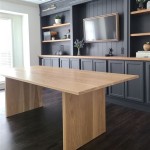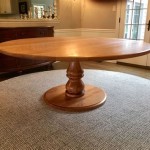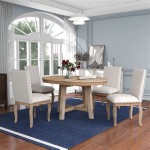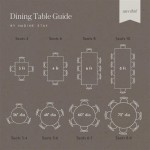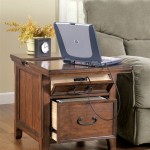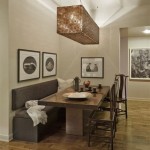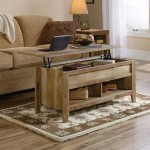Dining Table Dimensions for 10
Selecting the appropriate dining table involves careful consideration of various factors, with dimensions being paramount. The size of a dining table dictates not only how many people can comfortably be seated but also how the table interacts with the overall spatial dynamics of the dining area. For a dining table designed to accommodate ten individuals, specific dimensional guidelines ensure functionality, comfort, and aesthetic harmony. This article provides a comprehensive guide to understanding the dimensions required for a ten-person dining table, encompassing various shapes and considerations for maximizing dining space.
Standard Dimensions for a Rectangular or Oval Dining Table for 10
The rectangular dining table remains a popular choice due to its versatility and efficient use of space. For seating ten people comfortably, a rectangular table should ideally measure between 84 to 96 inches in length (7 to 8 feet) and 42 to 48 inches in width. This provides approximately 24 inches of personal space per diner, a generally accepted standard for comfortable elbow room. The width ensures sufficient space for place settings, serving dishes, and centerpieces without feeling overly crowded.
Oval dining tables share similar dimensional requirements with their rectangular counterparts. The length should fall within the 84 to 96 inch range, and the width should be approximately 42 to 48 inches. The oval shape, however, offers a slightly different dynamic, as the absence of sharp corners allows for easier conversation and movement around the table. In some instances, an oval table might feel less imposing in a smaller room compared to a rectangular table of similar dimensions.
These dimensions are based on standard dining chair widths (approximately 18-20 inches). If using wider chairs, the overall table dimensions may need adjustment to prevent overcrowding. Additionally, consider the depth of the chair when pulled out for seating, ensuring adequate space for maneuvering around the table. Aiming for at least 36 inches of clearance between the table edge and any walls or furniture is crucial for comfortable movement.
Considerations for Round Dining Tables for 10
Round dining tables offer a more intimate and conversational setting. However, accommodating ten diners comfortably requires a significantly larger diameter compared to rectangular or oval tables. A round dining table designed for ten people should measure at least 60 to 72 inches in diameter (5 to 6 feet). This allows sufficient surface area for place settings and serving dishes while maintaining a sense of closeness. Smaller diameters will feel cramped and limit usability.
A diameter of 60 inches is the absolute minimum for a round table seating ten, and it might feel somewhat crowded, particularly if using larger dinner plates or serving dishes. A diameter closer to 72 inches offers a more generous and comfortable dining experience. When selecting a round table, factor in the central placement of the table and its impact on room flow. Round tables require ample surrounding space to allow for easy movement and prevent obstruction of pathways.
The circumference of a round table also impacts conversation flow. While the absence of corners promotes inclusivity, a very large diameter can make it difficult to converse with individuals seated directly across the table. This is a trade-off to consider when prioritizing seating capacity over conversational intimacy.
Square Dining Tables and Other Unique Shapes
Square dining tables designed for ten people are less common due to their large footprint and potential for spatial challenges. To accommodate ten people, a square table would need to measure at least 60x60 inches to 72x72 inches. This dimension presents significant challenges in terms of room layout as it requires a substantial amount of unobstructed space around the table to avoid feeling cramped.
Square tables can work well if the dining room is proportionately large and square itself, allowing ample space for movement and preventing the table from dominating the room. However, in smaller or more rectangular dining areas, a square table of this size can feel overwhelming and impractical.
Beyond the standard shapes, custom or uniquely shaped dining tables can be created to accommodate ten diners. However, careful planning and consideration of ergonomics are essential. Irregular shapes, while visually interesting, may not provide optimal seating arrangements or comfortable spacing between diners. Prioritizing functionality and ensuring adequate personal space for each diner is crucial when deviating from conventional table shapes.
For unusual shapes, calculating the linear feet of usable table edge is a helpful metric. Aim for at least 20 feet (240 inches) of usable edge to comfortably accommodate ten people, allowing for at least 24 inches per person. This method can be applied to irregular shapes to ensure sufficient seating space.
Leg Placement and Apron Height Considerations
The placement of table legs is a crucial factor often overlooked when determining appropriate dining table dimensions. Table legs positioned too close to the corners can restrict legroom for diners, particularly those seated at the ends of the table. Ideally, table legs should be recessed sufficiently to allow ample space for chairs to be pushed fully under the table without obstruction.
For rectangular tables, consider leg placement to ensure that two chairs can comfortably fit between the legs on each side. This is especially important for tables with pedestal bases, as the base's footprint will dictate the available legroom. If the pedestal is too wide, it can significantly reduce the number of people who can comfortably be seated.
Apron height, the distance between the table's edge and the underside of the table, is also a critical consideration. A low apron height can restrict legroom, particularly for taller individuals. Standard dining tables typically have an apron height of around 25 to 27 inches. Before purchasing a table, measure the distance from the floor to the top of the chair's arms to ensure sufficient clearance. Chairs with higher arms may not fit comfortably under tables with low apron heights.
Room Size and Table Placement
Choosing the right dining table dimensions is only one aspect of creating a functional and aesthetically pleasing dining space. Room size and table placement are equally important factors. It is essential to measure the dining area accurately before selecting a table to ensure it fits comfortably without overwhelming the space.
As a general guideline, allow at least 36 inches of space between the edge of the dining table and any walls or furniture. This allows ample room for diners to move freely around the table without bumping into obstacles. In smaller dining areas, 30 inches might be acceptable, but it can feel somewhat cramped, especially when chairs are pulled out for seating.
Consider the placement of doors, windows, and other architectural features when determining table placement. Avoid placing the table in a location that obstructs doorways or walkways. Natural light can enhance the dining experience, so positioning the table near a window is often desirable. However, be mindful of direct sunlight, which can cause glare and discomfort.
Using painter's tape to mark out the dimensions of the proposed table on the floor can be a helpful way to visualize how the table will fit in the space. This simple technique allows for a realistic assessment of room flow and potential obstructions before making a purchase.
Material Thickness and Edge Details
While focusing on length and width, the thickness of the tabletop and the edge details also contribute to the overall perceived size and comfort of the dining table. A thick tabletop can create a sense of solidity and quality, but it can also make the table appear more visually heavy, especially in smaller rooms.
Edge details, such as beveling, rounding, or chamfering, can soften the appearance of the table and make it feel more comfortable to lean against. Sharp edges can be uncomfortable and potentially hazardous, especially for households with young children. Rounded or beveled edges offer a more forgiving and user-friendly design.
The material choice also influences the perceived size and weight of the table. Glass tabletops, for example, can create a sense of openness and airiness, making the room feel larger. Conversely, solid wood tabletops can add warmth and texture but may make the table appear more substantial.
Extending Tables: A Solution for Flexible Seating
For individuals who occasionally need to accommodate ten diners but do not require a large table on a daily basis, an extending dining table can be a practical solution. These tables typically feature leaves that can be added or removed to adjust the table's length to accommodate varying numbers of guests.
When fully extended, an extending table designed for ten people should meet the dimensional guidelines for a standard rectangular or oval table, as described previously. However, when not extended, the table can be significantly smaller, making it more suitable for smaller dining areas or everyday use. The mechanism for extending the table should be robust and easy to operate. Ensure that the leaves fit securely and seamlessly with the main tabletop to create a smooth and even surface.
The storage of the leaves is also a practical consideration. Some extending tables have built-in storage compartments for the leaves, while others require separate storage. Consider where the leaves will be stored when not in use and ensure that the storage location is easily accessible.
In conclusion, selecting the correct dimensions for a dining table designed to seat ten people requires careful consideration of room size, shape, materials, and individual preferences. By following the guidelines outlined in this article, individuals can make informed decisions that ensure a functional, comfortable, and aesthetically pleasing dining experience.

Dimensions For 10 Person Dining Table Length Of A Seater

How Do I Choose The Right Size Of Solid Wood Dining Table Set For My S Picket Rail Custom Sofas Furniture

How To Choose The Right Dining Table Size And Shape Contemporary Wooden Furniture Hand Made In Cincinnati Ohio Modern Traditional Craft

Table Size Seating Capacity Round Rectangular More

Round Dining Table Seats 10 Designer Picks Photos

Chvans Large Mobile Extendable Dining Table For 6 10 Modern Wood Kitchen Rectangular Room Living

The Ultimate Guide Dining Kitchen Table Dimensions

Choosing The Right Dining Table Size For Your Space Amish Furniture Factory

Coaster Cornelia Farmhouse Coastal Grey Wood Top 82 In Trestle Dining Table Seats 10 107441 The Home

4 Steps For Buying A Dining Table Guide

